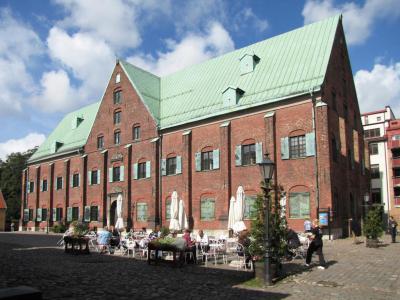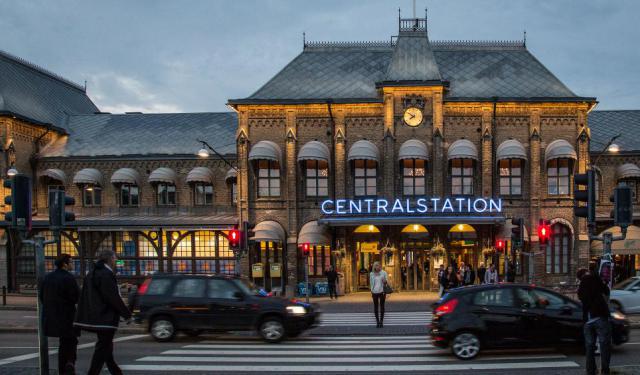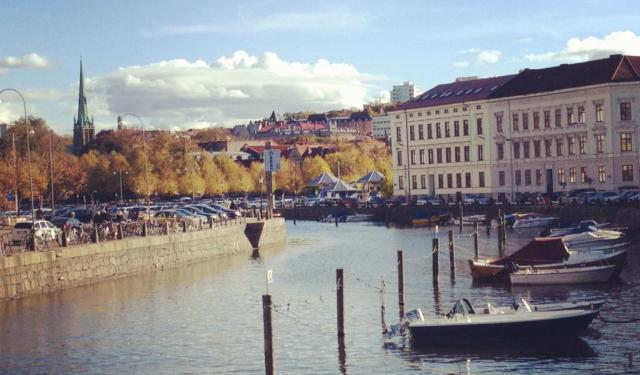Kronhuset (Crown House), Gothenburg
The Crown House (Kronhuset) is a prominent redbrick structure in Västra Nordstaden, Gothenburg. Its construction, spanning from 1643 to 1654, aligns it as one of Gothenburg's oldest secular buildings, sharing this honor with the Torstenson Palace. Simon de la Vallée, a notable royal architect, is credited with its design, characterized by Dutch architectural influences.
Originally serving as an arsenal for the city garrison and a granary to safeguard food supplies during sieges, the Crown House transitioned from state ownership to that of Gothenburg Municipality in 1927. Its historical significance led to its listing as a protected building in 1968.
The architectural features of the Crown House are distinctive, showcasing Dutch influences, particularly evident in the Rikssal (national hall) on the ground floor. Notably, the absence of load-bearing pillars in the Rikssal is a testament to the innovative construction techniques employed during its era. Additionally, the Flemish tapestry, dating back to around 1690, adds to the building's cultural heritage.
Over the centuries, the Crown House underwent modifications, including window alterations and the installation of wooden emblems, possibly salvaged from the demolished Kungsporten, during the 18th and 19th centuries, respectively.
Adjacent to Crown House are the Crown House sheds (Kronhusbodarna), eighteenth-century structures painted in vibrant yellow hues, encircling the courtyard. Recognized as listed buildings since 1968, these sheds now accommodate various shops and tenants, offering pottery, glassware, leather products, interior furnishings, a watchmaker, and a cafe. Moreover, an annual arts and crafts market held in the courtyard has become a tradition since the early 2000s.
At the rear of the sheds lies the Crown Park (Kronhusparken), a small park established in 1930 and renovated in 1964 following its acquisition by the city. Covering approximately 2000 square meters, the park features a bust of the poet Johan Anders Wadman, sculpted by Johan Peter Molin, commemorating his residency in Gothenburg from 1814 to 1838.
Originally serving as an arsenal for the city garrison and a granary to safeguard food supplies during sieges, the Crown House transitioned from state ownership to that of Gothenburg Municipality in 1927. Its historical significance led to its listing as a protected building in 1968.
The architectural features of the Crown House are distinctive, showcasing Dutch influences, particularly evident in the Rikssal (national hall) on the ground floor. Notably, the absence of load-bearing pillars in the Rikssal is a testament to the innovative construction techniques employed during its era. Additionally, the Flemish tapestry, dating back to around 1690, adds to the building's cultural heritage.
Over the centuries, the Crown House underwent modifications, including window alterations and the installation of wooden emblems, possibly salvaged from the demolished Kungsporten, during the 18th and 19th centuries, respectively.
Adjacent to Crown House are the Crown House sheds (Kronhusbodarna), eighteenth-century structures painted in vibrant yellow hues, encircling the courtyard. Recognized as listed buildings since 1968, these sheds now accommodate various shops and tenants, offering pottery, glassware, leather products, interior furnishings, a watchmaker, and a cafe. Moreover, an annual arts and crafts market held in the courtyard has become a tradition since the early 2000s.
At the rear of the sheds lies the Crown Park (Kronhusparken), a small park established in 1930 and renovated in 1964 following its acquisition by the city. Covering approximately 2000 square meters, the park features a bust of the poet Johan Anders Wadman, sculpted by Johan Peter Molin, commemorating his residency in Gothenburg from 1814 to 1838.
Want to visit this sight? Check out these Self-Guided Walking Tours in Gothenburg. Alternatively, you can download the mobile app "GPSmyCity: Walks in 1K+ Cities" from Apple App Store or Google Play Store. The app turns your mobile device to a personal tour guide and it works offline, so no data plan is needed when traveling abroad.
Kronhuset (Crown House) on Map
Sight Name: Kronhuset (Crown House)
Sight Location: Gothenburg, Sweden (See walking tours in Gothenburg)
Sight Type: Attraction/Landmark
Guide(s) Containing This Sight:
Sight Location: Gothenburg, Sweden (See walking tours in Gothenburg)
Sight Type: Attraction/Landmark
Guide(s) Containing This Sight:
Walking Tours in Gothenburg, Sweden
Create Your Own Walk in Gothenburg
Creating your own self-guided walk in Gothenburg is easy and fun. Choose the city attractions that you want to see and a walk route map will be created just for you. You can even set your hotel as the start point of the walk.
Historical Buildings Walking Tour
Like the majority of Swedish cities, Gothenburg is constantly re-inventing itself whilst continuing to celebrate its past. The latter is no more evident than in the city’s stunning historic architecture, manifested in a wonderful collection of stately old buildings, carefully preserved amid the relatively new ones.
Gothenburg’s architecture comes in a wide range of styles, from Gothic to... view more
Tour Duration: 2 Hour(s)
Travel Distance: 3.3 Km or 2.1 Miles
Gothenburg’s architecture comes in a wide range of styles, from Gothic to... view more
Tour Duration: 2 Hour(s)
Travel Distance: 3.3 Km or 2.1 Miles
Gothenburg Introduction Walking Tour
Gothenburg is Sweden’s second-largest city. Its river-side location has been vital in its development from a trading colony to a modern, vibrant city. Today, Gothenburg is known for its culture, fabulous cuisine, and international flair.
Gothenburg was founded in 1621 by King Gustavus Adolphus. The king gave generous tax cuts to Dutch allies and encouraged German and Scottish residents to... view more
Tour Duration: 2 Hour(s)
Travel Distance: 2.7 Km or 1.7 Miles
Gothenburg was founded in 1621 by King Gustavus Adolphus. The king gave generous tax cuts to Dutch allies and encouraged German and Scottish residents to... view more
Tour Duration: 2 Hour(s)
Travel Distance: 2.7 Km or 1.7 Miles





